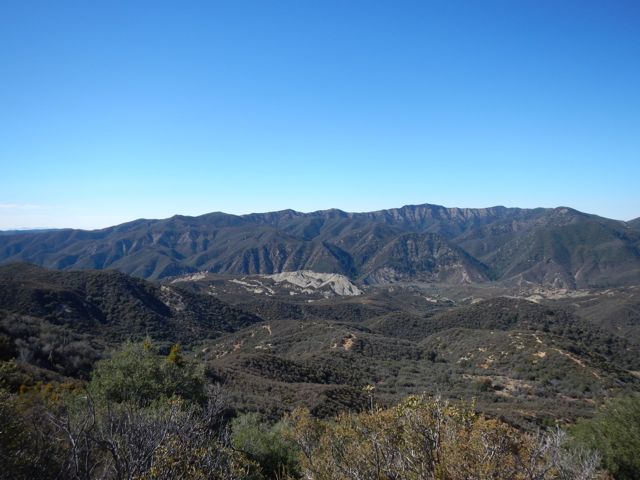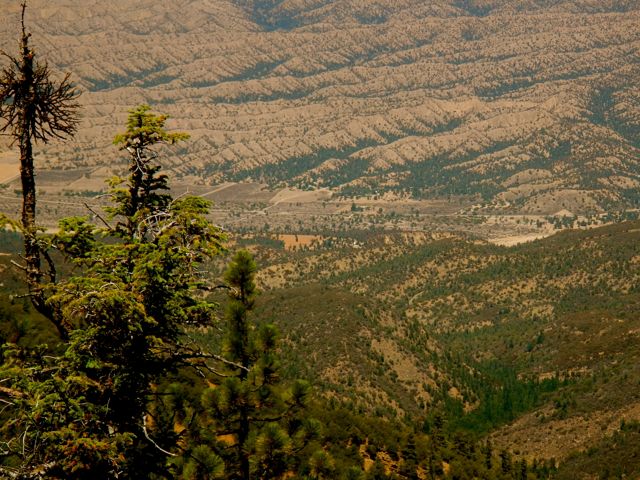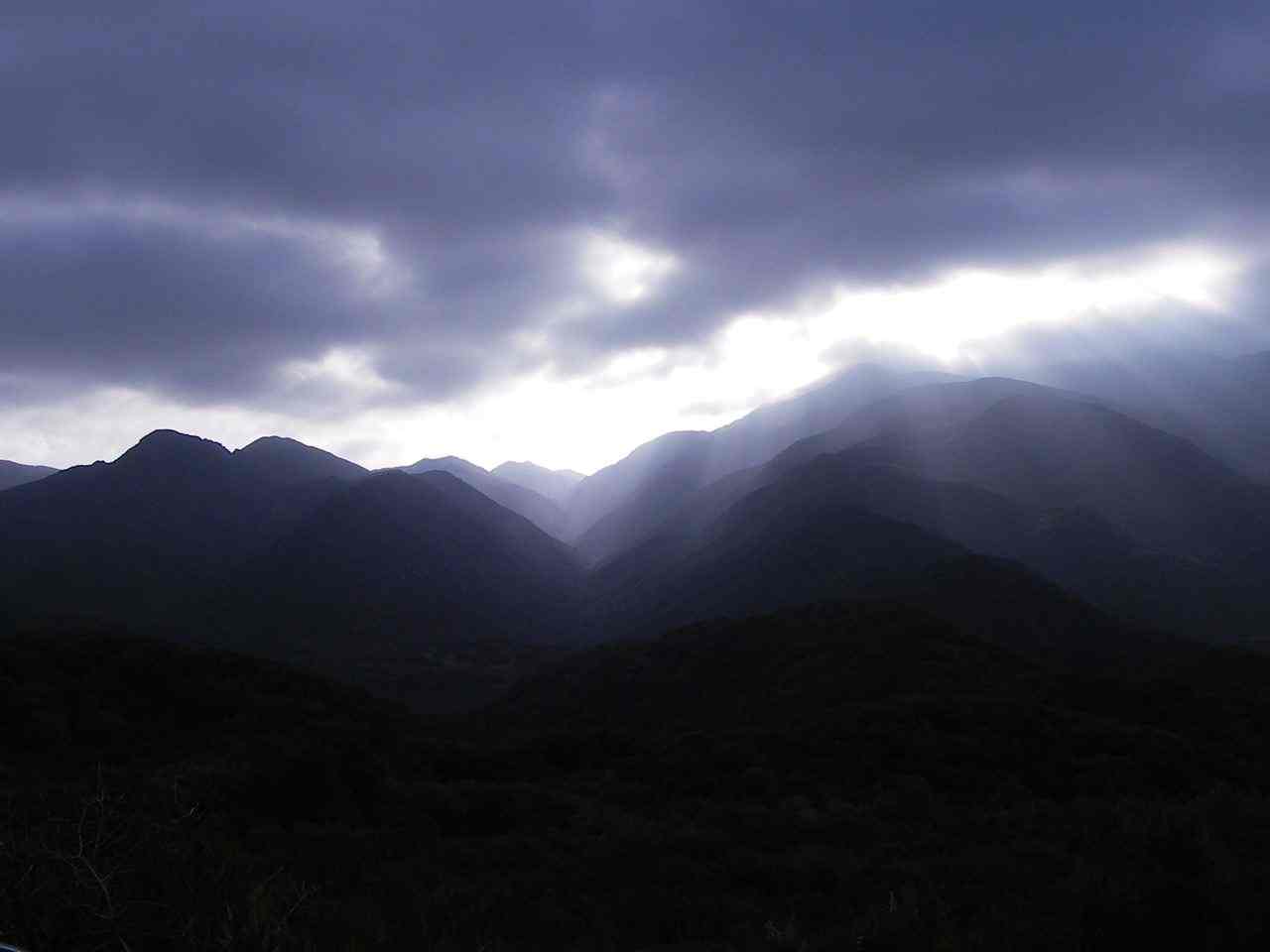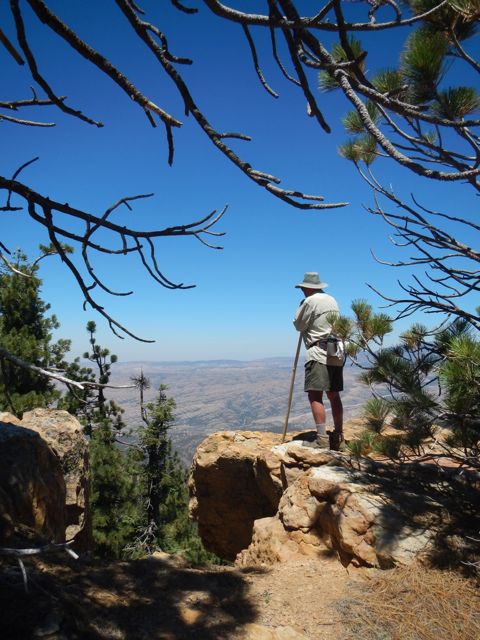Chorro Grande Springs and Reyes Peak
Ten-Hour Day Hike Gaining 3,000 Vertical Feet

Hike: Strenuous 14-mile trek from Hwy. 33 up 3,000 ft. vertical gain to Chorro Grande Springs (6,400 ft.), and then on to Reyes Peak
Mileage: 5.1 miles to Chorro Grande Springs, 0.8 mile to the closed Reyes Peak Campground, and 1.1 to Reyes Peak itself (7,500 ft.)
Time: Hiking steadily with two-hour lunch at Reyes Peak, 10 hours on the trail; suitable for fit and sturdy children over 10.
Maps: Sespe Wilderness Trail Map (Tom Harrison Maps); USGS 7.5 series “Reyes Peak”; Craig Carey, Hiking & Backpacking Santa Barbara and Ventura, Route 75 with his Map 18 (he begins the hike from the top at Reyes Peak Camp)
I made my first day hike to the entrancing Chorro Grande Springs in 1974, and did it again last week with the same guru Franko. While it’s obvious my physical frame has changed in the last 39 years, the alterations along the rugged trail up the side of Pine Mountain to the magic spring are less obvious. Sun, wind, and rain erosion, plus the relentless seasons all take their toll, yet the spectacular vistas and ascension into noble coniferous glades elevate the mood and inspire the heart.

Pine Mountain Road off of Highway 33 has been temporarily closed, so the only frontside way to the Springs and Reyes Peak is the route rising up Chorro Grande Springs Trail (23W05) — the trail sign is 66 miles from my home on Santa Barbara’s Westside, and it’s quite visible on the right side of 33 after you pass the well-known climbing wall in Sespe Gorge.
An August hike into these arid zones of the National Forest near the Sespe Wilderness requires both some craziness and a very early start. We began hiking at 7:15 a.m. and didn’t return to the truck until 5 p.m. The hike was quite demanding in several ways: the blasting summer heat, incessant glare, a vertical gain of almost 3,500 ft. to Reyes Peak, and dehydrating dry air affecting face, eyes, nose, and throat.
The immediate return for making this effort starts with the silence, finds augmentation through solitude, and has a crowning impact with a continuous reel of stunning vistas. The view “back” (south) toward the sea reveals dark ridge after dark serrated ridge, and at the top we had magnificent visions of the Santa Monica Mountains, Santa Cruz Island, and even bits of Catalina (yes) and Santa Rosa. You will also enjoy unusual views of the Topatopas and jagged Nordhoff Peak .
Radical German philosopher Peter Sloterdijk has been inveighing against our epoch’s depressive “cynicism” for many years (e.g., his 1983 Critique of Cynical Reason), and in his recent book You Must Change Your Life he cogently criticizes our “learned helplessness” based on a revolt that led us into “a clever melancholy.” Sloterdijk wants a return to the 1960s values of spontaneity and accepting the wisdom of the body: I read this as a paean to throwing off the tyranny of screens in our time and what he labels “the galloping inflation of chatter.”

There wasn’t much extra breath for “chatter” on our trek, and no space for that continuous partial attention afflicting the 21st century. The spring itself is one of the two main highlights of the hike. The 5.1 miles uphill to Chorro Grande was great for our lungs and legs, and after Oak Camp it ascended sharply (no water at Oak). Shortly before entering the narrow canyon with the spring, we found ourselves among fragrant conifers: ponderosa pines and stands of sugar pines and spruce. Fortunately, the spring was pumping out a steady flow (not quite chorro, however), and the water was truly delicious; we slowly drank quite a bit and refilled our water bottles. Splashing the holy elixir on face and hair felt transformative and exciting.
After a brief respite, we struggled up the last 0.8 mile very steep ascent to the closed Reyes Peak Campground, and admired the new asphalt road that crews had just laid. We encountered the only humans we saw on the whole trip there: two tough young women backpackers from Santa Barbara, out for a few days with their cool dog. I admired them for getting out in August and for taking on this hike with backpacks. Franko and I weren’t sure it was wise to have the long-haired dog along due to rattlesnakes and possible dehydration.
From the camp we went on the dirt road continuation of Pine Mountain Road to a three-way trail fork: the signed “left” trail leads down the backside of Reyes Peak into the Sespe Wilderness to Haddock Camp, and the (closed) road to the right leads to some private ranches. The tiny trail straight up the mountain — the Middle Path — will take hikers to the destroyed Reyes Peak lookout and then on to rounded Reyes Peak itself. We chose this very steep but short trail and soon found more captivating vistas looking north and south.

In my last column [http://www.independent.com/news/2013/aug/06/mt-pinos-sawmill-peak/] we could descry the wild Cuyama badlands, and from the ridge near Reyes Peak we saw them again in all their dry horror and natural symmetry, amid other impressive views. The human brain reels from such magnitude: Santa Cruz and Catalina islands on one side (we also picked out our local Broadcast Peak) and the forbiddingly arid badlands on the backside, including more views of the snaky and dry Cuyama River. Sloterdijk would approve, calling these startling experiences, after hours of heavy climbing, one of the methods to escape the “prison of reason.”
Today’s America reflects a sort of generational world-weariness, and as Sloterdijk stresses, we’re at “the final horizon of western technological titanism” — the drones and iWorld will solve everything! Since Nietzsche intoned that “God is dead,” how do humans fill the metaphysical void left by the departure of messianic religion?
One path is to ritually practice moving ourselves toward open spaces and the wilderness (wildeor), to escape the omnipresent screens and inane twitterings of our time, and to regain the idea of discovering an external ally. Regular and repetitive day hikes and backpacks will help locate such a spiritual helper or ally (not “god”).
I would claim the Native American idea of the “atishwin” — a spirit guide or talismanic helper. You may be able to find this resource yourself, but many treks “outside” the comfortable Santa Barbara lifestyle and imprisoning screens will be necessary.



